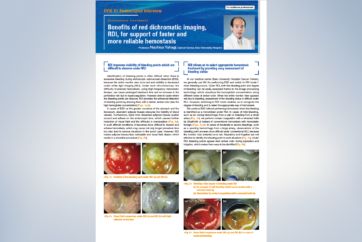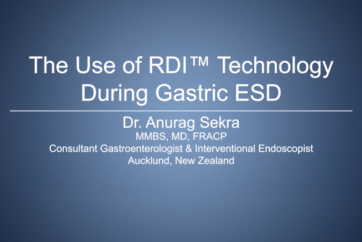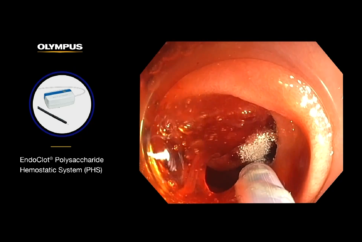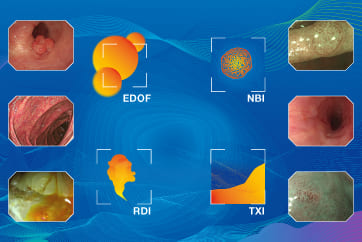DualKnife
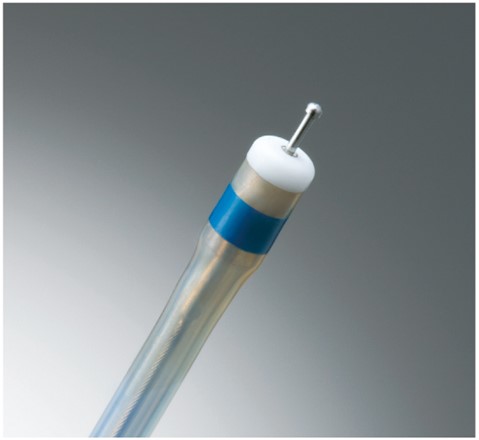
Model KD-650L
Dr. Naohisa Yahagi
Keio Universitiy
Interview With The Expert
DualKnife can be set to either of two lengths. When the knife is extended to maximum length, it can be used for incision and dissection. When the knife is retracted, the knife tip still protrudes by 0.3 mm so it can be used for marking as well as simple haemostasis. The knife length can be set to either 2 mm or 1.5 mm.
The 2 mm length is for gastric ESD, while the 1.5 mm length is for oesophageal ESD. The knife tip has a projecting section, which catches the tissue during incision and dissection, considerably improving knife manoeuvrability.
Moreover, the dome-shaped knife tip improves the knife contact during incision and dissection. In addition, the outer diameter of the sheath is just 2 mm, so smooth water and smoke suction is possible even when the knife is retracted in the instrument channel.
but the thin, needle-shaped design of DualKnife provides superior incision performance. Consequently, physicians typically set DualKnife’s high-frequency power about 10 W lower than FlexKnife. In addition, burnt tissue does not get attached to DualKnife compared to FlexKnife. Even when residue is adhered to the tip, it can be removed by moving the knife back and forth a few times and allows continuous use.
While FlexKnife needs fine adjustment for knife length, DualKnife can accurately set the knife length into two lengths. This also makes it easier for the operation assistant to handle.
The thinness of the sheath could make it more difficult to transmit force to the tip when the sheath is extended. It is more effective to use the multi-bending endoscope when treating a lesion in a hard-to-approach region.
I sometimes switch to HookKnife when I encounter advanced fibrosis during dissection, limited space for endoscope manoeuvre, or unstable knife contact due to severe respiratory movements. Haemostasis for small amount of bleeding can generally be achieved by bringing the retracted knife in contact for coagulation. For pulsatile bleeding, I use Coagrasper.
Applicability of DualKnife
Difficulty per region
◯ : Easy. No mark: Ordinary. △ : Difficult.
| Cardiac region | △ | |
|---|---|---|
| Fornix | △ | |
| Lesser curvature of upper body | ||
| Greater curvature of upper body | △ | Bleeding makes a pool of blood. |
| Anterior wall of upper body | △ | |
| Posterior wall of upper body | △ | Tends to bleed heavily. |
| Lesser curvature of middle body | ◯ | |
| Greater curvature of middle body | △ | Bleeding makes a pool of blood. |
| Anterior wall of middle body | △ | |
| Posterior wall of middle body | ||
| Lesser curvature of lower body | When gastric angulus widens, distance is made between the device and mucosa and it is difficult to transmit proper force. Multi-bending endoscope enables easy operation. |
|
| Greater curvature of lower body | ||
| Anterior wall of lower body | ||
| Posterior wall of lower body | ||
| Lesser curvature of anterior wall | ◯ | |
| Greater curvature of antrum | ◯ | |
| Anterior wall of antrum | ◯ | |
| Posterior wall of antrum | ◯ | |
| Pyloric ring | △ |
| Intravenous anaesthesia | Premedication | General anaesthesia | Monitoring |
|---|---|---|---|
| Less than 2 hours | Pethidine hydrochloride 35 mg + Cercine (diazepam)* 5 to 10 mg (appropriate amount) |
More than 2 hours | All cases: SpO2, blood pressure |
| Electrosurgical unit | VIO-300D (Erbe) |
ESG-100 (Olympus Medical Systems) |
|---|

| Device | Caution | Setting | |
|---|---|---|---|
| DualKnife | Retract the knife. | SoftCoag 50W Effect4 |
SoftCoag 50W |

| Epineprina | Carmín de índigo | ||
|---|---|---|---|
| Glyceol (glicerina fructuosa concentrada)* |
Utilizado (dilución 10,000X) |
Utilziado | Los precios bajos permiten el uso de glyceno sin generar una preocupació en la cantidad. El daño mínimo al tejido permite no preocuparse po su uso. |
| MucoUp (hialuronato De sodio)* |
Utilziado (dilución 10,000X) |
Utilziado | Conveniente cuando se el levantamiento no es suficiente con Glyceol debido a la buena retención de levantamiento. Alto precio. . |
| Añadir carmín de índico, el cual tiñe los vasos de azul claro. Con tinta de carmín de índigo, la capa de submucosa se puede identificar fácilmente incluso con el tejido quemado. |
|||

| Device | Caution | Setting | |
|---|---|---|---|
| DualKnife | Do not perform circumferential incision. Incise only the part to be dissected and dissect immediately. |
Stomach: DryCut 30W Effect 3 Oesophagus: DryCut 30W Effect 2 |
ForcedCoag2 30W or PulseCut slow 30W |

| Device | Caution | Countertraction | Setting | |
|---|---|---|---|---|
| DualKnife | Move the knife slowly when dissecting small vessels. | Usually use a distal attachment. Also, use gravity to lift up the dissected mucosa. |
SwiftCoag, 40W Effect4 |
ForcedCoag2 30W |

| Device | Caution | Setting | |
|---|---|---|---|
| DualKnife | For venous bleeding, contact the bleeding point with the retracted knife and supply current for a very short period. | SwiftCoag, 40W Effect4 |
ForcedCoag2 30W |
| Coagrasper | For arterial bleeding, use Coagrasper. | SoftCoag 50W Effect4 |
SoftCoag 50W |
| Apply the auxiliary water jet function to confirm the bleeding point. | |||
Small vessels: Use the SwiftCoag mode and cut by moving the knife slowly.
△ Large vessels: Use haemostatic forceps in the SoftCoag mode. Grasp the vessel, lift it up slightly and supply current.
| Method | Timing | Tip |
|---|---|---|
| Clip suture. | After finding a perforation, perform additional dissection to create a margin and then attach a clip. | After placing a clip, exhaust air slightly to remove the tension of the muscle layer before closing. |
* May not be available in your area.
- Content Type

